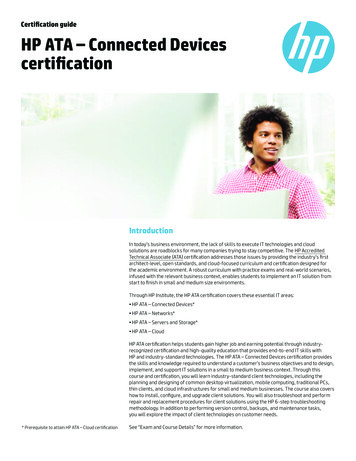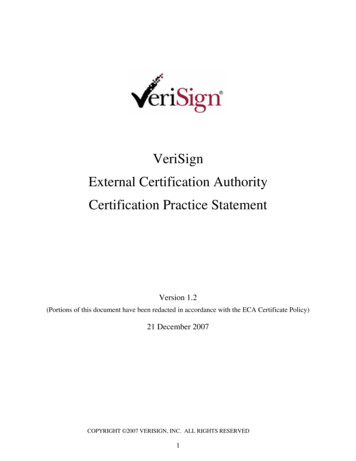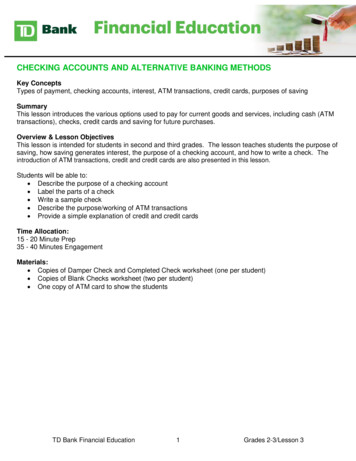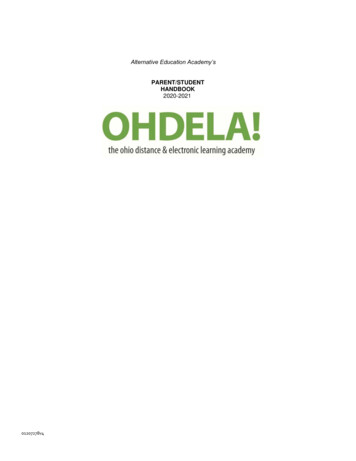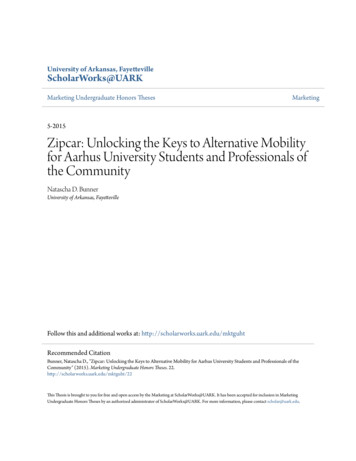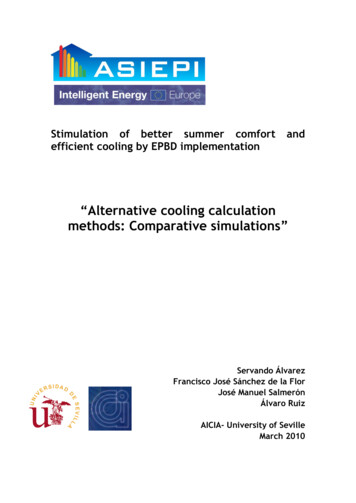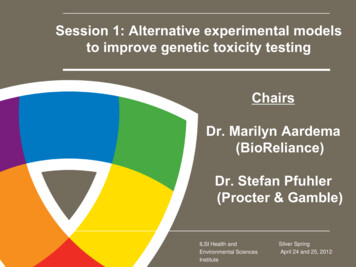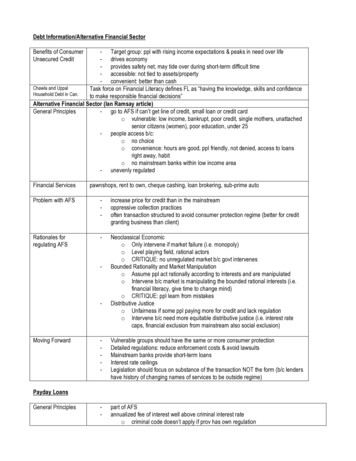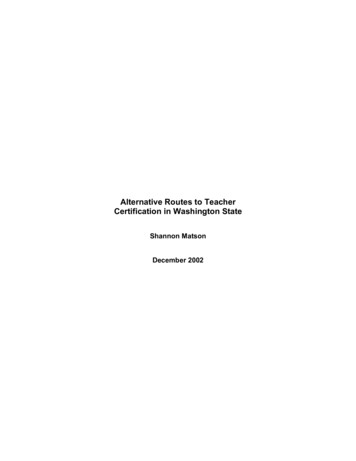
Transcription
Alternative Routes to TeacherCertification in Washington StateShannon MatsonDecember 2002
Alternative Routes to TeacherCertification in Washington StateShannon MatsonDecember 2002Washington State Institute for Public Policy110 Fifth Avenue SE, Suite 214Post Office Box 40999Olympia, Washington 98504-0999Telephone: (360) 586-2677FAX: (360) 586-2793URL: http://www.wsipp.wa.govDocument No. 02-12-2901
WASHINGTON STATE INSTITUTE FOR PUBLIC POLICYMissionThe Washington Legislature created the Washington State Institute for Public Policy in1983. A Board of Directors—representing the legislature, the governor, and publicuniversities—governs the Institute, hires the director, and guides the development of allactivities.The Institute’s mission is to carry out practical research, at legislative direction, on issues ofimportance to Washington State. The Institute conducts research activities using its ownpolicy analysts, academic specialists from universities, and consultants. New activitiesgrow out of requests from the Washington legislature and executive branch agencies, oftendirected through legislation. Institute staff work closely with legislators, as well aslegislative, executive, and state agency staff to define and conduct research on appropriatestate public policy topics.Current assignments include projects in welfare reform, criminal justice, education, youthviolence, and social services.Board of DirectorsSenator Karen FraserSenator Jeanine LongSenator Betti SheldonSenator James WestRepresentative Ida BallasiotesRepresentative Jeff GomboskyRepresentative Helen SommersRepresentative Steve Van LuvenStaffRoxanne Lieb, DirectorSteve Aos, Associate DirectorDennis Braddock, Department of Social and Health ServicesMarty Brown, Office of Financial ManagementDouglas Baker, Washington State UniversityStephen Jordan, Central Washington UniversityMarsha Landolt, University of WashingtonThomas L. "Les" Purce, The Evergreen State CollegeKen Conte, House Office of Program ResearchStan Pynch, Senate Committee Services
CONTENTSReport Summary. 1Introduction . 7I.What Are Alternative Routes to Teacher Certification? . 9II. What Is the Status of Washington’s Alternative Route Partnerships?. 19III. Who Are Washington’s Alternative Route Interns?. 31IV. What Are the Next Steps for the Institute’s Evaluation? . 41AppendicesAppendix A: South Sound Transitions Consortium . 43Appendix B: South Sound Partnership . 47Appendix C: Skagit Valley Network . 51Appendix D: Southwest Washington Consortium . 53Appendix E: Puget Sound Partnership . 57Appendix F: Seattle Transitions to Teaching. 59Appendix G: State Standards for Residency Teaching Certificate . 61Appendix H: History of Alternative Certification Efforts in Washington State . 63Appendix I: Washington’s Teacher Certification Programs. 65Barbara McLain worked on this report during her time with the Institute.The author wishes to thank program coordinators from the six alternative route pilotprograms for their time and valuable insights. Thanks to the editing and feedback providedby Debra Fabritius, Janie Maki, and Kathe Taylor. And, finally, thanks to Barbara McLainfor setting the foundation for this evaluation and providing support throughout its production.
REPORT SUMMARYStudy DirectionIn creating the state grants for alternative routes to teacher certification, the 2001Washington Legislature also directed the Washington State Institute for Public Policy(Institute) to:submit to the education and fiscal committees of the legislature, the governor, thestate board of education, and the Washington professional educator standardsboard, an interim evaluation of partnership grant programs funded under thischapter by December 1, 2002, and a final evaluation by December 1, 2004.1The Institute received funding from the Office of the Superintendent of Public Instruction(OSPI) to incorporate the four federally funded projects in this evaluation.The key research questions addressed in this interim report are: What are alternative routes to teacher certification? What is the status of Washington’s alternative route partnerships? Who are Washington’s alternative route interns? What are the next steps for the Institute’s evaluation?BackgroundWashington’s alternative route programs were created by the 2001 Legislature based onthe recommendations of the Professional Educator Standards Board (PESB). 2 TheLegislature articulated four primary objectives for alternative routes to teacher certification:1. Provide high-quality preparation;2. Offer flexibility and expedience to prospective teachers;3. Target shortage subject areas and geographic locations; and4. Meet state standards for teacher preparation. 3For the 2001–03 biennium, the Legislature appropriated 2 million to support mentoredinternships and forgivable loans to assist current school staff with tuition costs. Additionally,in December 2001, OSPI received a 1.2 million federal grant to help mid-careerprofessionals become part of the teaching force.1E2SSB 5695, Section 8; Chapter 158, Laws of 2001.E2SSB 5695; Chapter 158, Laws of 2001.3E2SSB 5695, Section 1; Chapter 158, Laws of 2001 – Legislative Intent.21
Washington State’s Partnership Grant ProgramIn 2001, the Legislature adopted the PESB’s recommendations and created statepartnership grant programs for school districts and state-approved teacher preparationprograms to offer three alternative routes to certification, each targeting a different type ofprospective teacher.4Exhibit 1Washington’s Alternative Routes to Teacher CertificationRouteIIIIIITarget InternsIntern QualificationsClassified instructionalstaff currentlyemployed by a districtTransferable associate degreeClassified staffcurrently employed bya districtBachelor’s degreeIndividuals notemployed by a districtor who hold emergencysubstitute certificatesBachelor’s degree3 years’ employment with adistrictOther Criteria*Seeking endorsement in: Special education Bilingual education ESLEndorsement in subject mattergeographic shortage area3 years’ employment with adistrictEndorsement in subject matteror geographic shortage area5 years’ professional experienceDemonstrated successfulexperience with students orchildrenNon-shortage areas allowedfor secondary schoolendorsementsAs outlined in the legislation authorizing alternative routes to teacher certification,partnership programs are to have the following characteristics:4 Mentored Internship. Interns must receive intensive classroom mentoring for atleast half of a school year. Trained Mentor. Programs must assure that mentor teachers are trained eitherthrough the OSPI mentor training academy or an equivalent local training. Performance-based. Programs rely on a teacher development plan that compareseach intern’s prior experience and education with the state standards for residencycertification and adjusts program requirements accordingly. Training and Coursework. Training and coursework for Route I interns shouldenable them to complete both a bachelor’s degree and residency certification in twoyears or less. Interns for Routes II and III should complete an intensive summerteaching academy complemented by flexibly scheduled training throughout the year.E2SSB 5695; Chapter 158, Laws of 2001.2
The 2 million appropriated by the Legislature for the 2001–03 biennium is used to support: Intern and Mentor Stipends. During the mentored internship, interns receive astipend equivalent to 80 percent of a first year teacher’s salary: 22,654 for the2002–03 school year. The remaining 20 percent provides a 5,664 stipend formentor teachers. Conditional Scholarship. Current classified staff (Routes I and II) receive tuitionassistance through conditional scholarships. Interns may receive loan forgiveness ofup to 4,000 a year for every two years they teach in a K–12 public school. Planning and Administration. No funds were allocated for planning oradministrative support.Federal Transitions to Teaching Grant ProgramWith the 1.2 million awarded to support Transitions to Teaching programs in WashingtonState, OSPI and the PESB created a second grant opportunity modeled closely after thestate’s partnership grant program. The two programs differ only in the following respects: The federal grant is targeted only to interns eligible for Route III. Transitions to Teaching interns receive a stipend of 5,000 during their internshipyear and an additional 3,000 during their first year teaching after certification.Mentor teachers receive a stipend of 500 during the internship year, and individualswho mentor the interns as first-year teachers also receive a 500 stipend.What Is the Status of Washington’s Alternative Route Partnerships?OSPI and the PESB awarded a seven grants (three state and four federal) to supportalternative route programs for the 2002–03 school year (see Exhibit 2). These partnershipshad a very short time to design and implement programs, generally three to six months. Atotal of 166 individuals are currently enrolled as alternative route interns.3
Exhibit 2Program Summary: Number of Interns by Route and Recruitment FocusFEDERAL GRANTSTATE GRANTPartnership NamePartnersNumber of Interns5Southwest Washington ConsortiumCity UniversityESD 1128 local area school districtsRoute I: 13Route II: 8Route III: 4Puget Sound PartnershipSeattle Pacific UniversityPuget Sound ESD8 local area school districtsRoute II: 6Route III: 11South Sound PartnershipPacific Lutheran UniversityGreen River Community College13 local area school districtsSeattle Transitions to TeachingUniversity of WashingtonSeattle School DistrictRoute I: 11Route II: 8Route III: 10Route III: 30 (Federal)Route III: 20Skagit Valley NetworkWestern Washington University4 local area school districtsRoute III: 16South Sound Transitions ConsortiumSt. Martin’s CollegePierce Community College2 local area school districtsRoute III: 29Alternative route programs have the following characteristics:5 All programs focused recruitment on shortage subject areas, including specialeducation, English as a Second Language, mathematics, and science. Someprograms also accepted interns based on willingness to teach in a shortage location. In general, alternative route programs tend to be more performance-based, andlearning opportunities were adapted to accommodate a year-long, intensiveinternship. Route I interns earn 90 or more quarter (equivalent) credits, while Route II and IIIinterns earn from 27 to 68 quarter credits, depending on the program. The total cost of tuition for Route I interns ranges from 7,200 to 35,000. The costof tuition for Route II and III interns ranges from 8,000 to 16,000. Tuition at thefour private institutions costs the same as or less than a comparable regular programat the same institution, while tuition at the two public institutions ranges from 1,000to 10,000 more than a comparable regular program.Including self and/or district-pay interns.4
Who Are Washington’s Alternative Route Interns? The median age of all interns responding to the Institute’s summer questionnaire6 is41. The widest range of ages is found among Route III interns, and more than twothirds of Route I interns are between 40 and 50 years old. Thirteen percent of interns reported an ethnicity other than Caucasian, compared to11 percent of all individuals earning beginning teacher certificates in Washington in1999–2000.7 Overall, slightly fewer than one-third (31 percent) are male, consistent with theproportion of males employed as classroom teachers in Washington State during the2001–02 school year (29 percent).8 However, among Route III interns, 40 percentare male and among Route I interns none are male. One-third of Route II and III interns report having a bachelor’s degree in science orengineering, with another 26 percent in arts and humanities, and the rest splitbetween social sciences and education (12 percent), business (8 percent), math (7percent), and other degrees in non-shortage subject areas. Nearly two-thirds (62 percent) of Route I and II interns report working as classroominstructional assistants prior to starting an alternative route program; 30 percentreport working as assistants for early childhood education or Title I remedialprograms. Nearly half of Route III interns report working in an education field prior toapplying, and the rest in business (23 percent), science or engineering (17 percent),or social services (6 percent).What Are the Next Steps for the Institute’s Evaluation?The Institute’s final report, due in December 2004, will focus on the remaining threeresearch questions:1) How do alternative route programs meet legislative objectives?2) How do alternative route programs and interns compare with regular programs andstudents?3) Are alternative route programs, as currently designed and implemented, a feasibleway for Washington to prepare teachers.6The information in this section is based on 140 surveys, with a return rate of 84 percent from 166interns. Surveys were returned by 19 Route I interns (79 percent), 21 Route II interns (95 percent), and100 Route III interns (83 percent).7OSPI, Annual Report 2000-2001: Certificates Issued and Certificated Personnel Placement Statistics(Olympia, WA: Office of the Superintendent of Public Instruction, February 2002).8OSPI, “Data Administration for School Year 2001-02: Personnel by Major Position and Sex” (Olympia,WA: Office of the Superintendent of Public Instruction, data table), http://www.k12.wa.us/dataadmin/R1808H01.pdf , November 20, 2002.5
INTRODUCTIONBackgroundTraditionally, to become a teacher in Washington, interns must graduate from a teacherpreparation program offered by a college or university and approved by the State Board ofEducation. Washington State has 22 higher education institutions (8 public and 14 private)offering teaching programs that lead to certification.Teacher shortages (particularly in certain subject areas or geographic locations) andinterest in attracting mid-career professionals into the teaching force have led 45 states(including Washington) to create alternative routes to teacher certification.9 Alternativeprograms typically combine college coursework with on-the-job training through a mentoredinternship or apprenticeship and are offered collaboratively by colleges and school districts.Washington’s alternative route programs were created by the 2001 Legislature based onthe recommendations of the Professional Educator Standards Board (PESB).10 TheLegislature articulated four primary objectives for alternative routes:1) High-quality preparation based on intensive field-based training, coursework, andstrong mentoring;2) Flexibility and expedience for interns, including a focus on demonstration ofcompetencies;3) Assistance in filling teacher shortages in certain subject areas and geographiclocations; and4) The expectation that alternative route interns meet the same state standards forcertification as regularly prepared interns.11For the 2001–03 biennium, the Legislature appropriated 2 million to support mentoredinternships and forgivable loans to assist current school staff with tuition costs. The PESBwas directed to distribute funds to partnerships of school districts and colleges that developthe alternative route programs.Additionally, in December 2001, the Office of the Superintendent of Public Instruction(OSPI) received a 1.2 million federal grant to help mid-career professionals become part ofthe teaching force. The funds are to be distributed in a similar fashion as the state grants topartnerships of alternative route programs.9C. Emily Feistritzer and David T. Chester, Alternative Teacher Certification: A State-by-State Analysis2002 (Washington, D.C.: National Center for Education Information, 2002).10E2SSB 5695; Chapter 158, Laws of 2001.11E2SSB 5695; Section 1, Chapter 158, Laws of 2001 – Legislative Intent.7
Study DirectionBoth the legislation creating alternative routes to teacher certification and the 2001–03appropriations act directed the Washington State Institute for Public Policy (Institute) toevaluate the state partnership grant programs for alternative teacher certification.12Findings will be reported to the Legislature in this interim report and a final report is dueDecember 2004. In May 2002, the Institute’s Board of Directors directed Institute staff toinclude the federally funded programs in the same evaluation.Research Questions and Interim ReportThe Institute’s study addresses the following research questions: Who are alternative route interns? How do alternative route programs meet legislative objectives? How do alternative route programs and interns compare with regular programs andstudents? Are alternative route programs, as currently designed and implemented, a feasibleway for Washington to prepare teachers?This interim report provides a preliminary overview of Washington’s state and federalpartnership programs and alternative route interns. This report focuses on the following:I. What are alternative routes to teacher certification?II. What is the status of Washington’s alternative route partnerships?III. Who are Washington’s alternative route interns?IV. What are the next steps for the Institute’s evaluation?Study MethodsDescriptions of the partnership programs were developed through review of programdocuments, site interviews with program coordinators, and telephone interviews. Aquestionnaire was used to collect information about the interns. We also examinedinformation about alternative routes to teacher certification in other states.12E2SSB 5695, Section 8; Chapter 158, Laws of 2001 and Section 608, Chapter 7, Laws of 2001, 2ndspecial session.8
I. WHAT ARE ALTERNATIVE ROUTES TO TEACHER CERTIFICATION?How Are Washington’s Teachers Currently Certified?Standards for Residency CertificationIn Washington State, standards for teacher preparation and certification are established bythe State Board of Education (SBE). Exhibit 3 illustrates the five primary steps to becomingcertified as a teacher in Washington.Exhibit 3Steps to Initial Teacher CertificationSteps to Initial Teacher Certification1. Meet minimum criteriaProspective teachers must be at least 18 years of age,provide evidence of good moral character, and hold abachelor’s degree.2. Pass a basic skills testAs of September 2002, individuals wishing to enter a teacherpreparation program must receive a passing score on astatewide basic skills test administered by the PESB.3. Successfully completea state-approvedteacher preparationprogramSince 2000, all teacher preparation programs approved bythe SBE must be “performance-based.” Rather thanspecifying the content of a program, the SBE requiresteacher interns to: Demonstrate their knowledge and skills based on 27standards;13 and Demonstrate positive impact on student learning.4. Obtain at least onesubject areaendorsementEndorsement areas identify the subject area an individual isconsidered qualified to teach (e.g., special education,mathematics, elementary education). The SBE is creatingperformance standards f
Pierce Community College 2 local area school districts Route III: 29 . 11 percent of all individuals earning beginning teacher certificates in Washington in 1999Œ2000.7 Overall, slightly fewer


